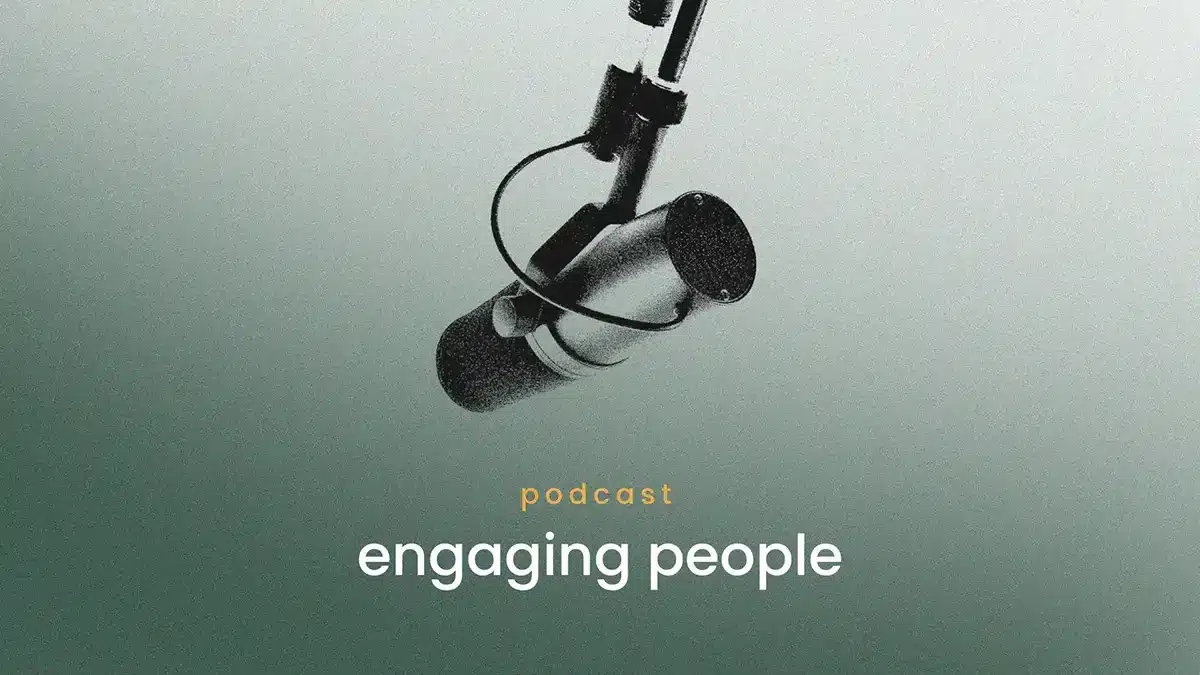In this episode, Matt Wride and Charles Rogel discuss one of DecisionWise’s core leadership competencies: Psychological Safety. They’ll dive into the academic research around psychological safety and explore how the concept has played out over time in the professional workplace. They’ll also share stories and give best practices on how to foster a feeling of psychological safety on your team.
Transcription
In this episode, Matt Wride and Charles Rogel discuss one of DecisionWise’s core leadership competencies: Psychological Safety. They’ll dive into the academic research around psychological safety and explore how the concept has played out over time in the professional workplace. They’ll also share stories and give best practices on how to foster a feeling of psychological safety on your team.
Transcription for “Creating Psychological Safety in the Workplace”
Charles: Hi, and welcome to the DecisionWise Engaging People podcast. My name is Charles Rogel. I work as the Vice President of Consulting here at DecisionWise. I’m joined today by our presenter, our President, Matt Wride.
Matt: Hi Charles, good to be with you.
Charles: Welcome. Today our topic is on psychological safety: how a manager can create a more psychologically safe workplace and what it really means in today’s workplace, as well as how to think about the behaviors that drive psychological safety within a team. So, Matt, do you want to set us up by talking about kind of how we define this term?
What is Psychological Safety?
Matt: Yeah. There’s no universal definition for psychological safety. We do know it’s a theme that’s important in the workplace. In other words, it’s an element of the employee experience that needs to be nurtured and it needs to be built. So that’s why it’s important to us here at DecisionWise. You cannot skip over psychological safety as part of your employee experience.
As I said, there’s no universal definition. Sometimes, it’s the ability to speak up without fear of retribution. Sometimes it’s that you can take actions without fear of negative consequences from your team members. And I’ll share it here in a second, a little bit of a personal anecdote that I really think goes to the heart of psychological safety, but in essence, it’s this notion that I can be my authentic self and I can take risks without having it bite me and come back to haunt me.
Charles: Yeah. So, there’s some history behind this term.
The History of Psychological Safety
Matt: So, in the 1960s, researchers [Edgar] Schein and [Warren] Bennis set out to talk about what we would call the precursor to what we now know as psychological safety.
And then in, [W. Edwards] Deming, the famous management guru, the one that was so heavily involved with Toyota and everything, he talked about it as a fundamental management principle the need to drive out fear. And I’m going to come back to that later because I really believe that that’s a great way to think about it conceptually: you drive out fear and then you allow people space to bring their best selves to work. So he, was at that early in the seventies and eighties.
Charles: One interesting example I think about with him is installing the buttons on the manufacturing assembly line to stop the line. All employees had the power now to stop the line if they saw a mistake, which was unheard of in the time.
Matt: Right.
Charles: You were fearful for screwing up and you just let mistakes fly by because you didn’t want to stop the line and be that guy.
Matt: There’s a great story where Toyota had a shared plant with a domestic manufacturer. They had installed those [buttons] and a Japanese executive is touring this plant and there is an American worker just falling behind having problems. He’s like, “Push the button. It’s okay.” It’s like, ”Oh no, no, I got this.” “Push the button. It’s okay.” He finally went up, took the worker’s hands, helped him push the button and he said, “Look, I’m sorry we put you in a position to fail.”
But that’s a principle of creating psychological safety. He didn’t ream him out. He said, I’m sorry that you’re here, but stop the process.” Be willing to stop it and let’s get it right.
Charles: The outcome is more important.
Matt: And that’s kind of a famous story that comes out of Deming’s work. Yeah, you’re right on.
In the nineties, William Khan, writing in the Academy of Management Journal, talked about the psychological conditions of personal engagement and disengagement at work. So, he starts to really bring in the psychology of it.
And then eventually, Amy Edmondson, a Harvard Professor of Leadership in 1999; she’s the one who full-on tackles the subject, makes it a leadership competency, and is the one who actually has my favorite definition of it, which is that: psychological safety is defined as a shared belief held by members of a team, that the team is safe for interpersonal risk-taking. It’s not just being extroverted, speaking up, and all that. It’s that you can take risks.
I told you I’d share with you in an anecdote about this. I remember working for Nancy Hadley in Seattle. She was my great manager when I was with Deloitte. I remember she came to us one time and she sent us all home at about 11:30. She said, “You’re no good to me. You’ll make more mistakes. I want to see you back here at six o’clock.” But this notion of pulling an all-nighter, she said it was just going to cause more problems. And she’s the same one that would every once in a while say, “It’s okay to take a mental health day.” Now, back then, we all felt like we had to hide it. Now we can sort of speak up and say, “Look, I need a day to recharge so that I can give my best effort the following 10 days.” But before then, we didn’t have that. Now, she taught me the importance of psychological safety. And now I see it everywhere where it’s permissible for someone to raise their hand and say, “Hey, I want to recharge. And I’ll see you guys in a day.” And everybody’s like, “Okay, that’s good.”
Anyway, that’s kind of the history of how psychological safety has come about and again, I’ve landed on this notion that it’s when team members feel safe to take risks and be vulnerable in front of each other. That’s the leadership competency that we now have and measure as part of the employee experience.
Measuring Psychological Safety in Surveys
Charles: Excellent. So then in terms of how we measure this, we asked several questions on our employee surveys, our 360 surveys, and I think that we dance around the topic and kind of measure it indirectly and more directly. Do you want to talk about some of those?
Matt: Yeah. Let me, jump down to those. So, some of our items that we use; these are statements that we ask people to respond to, and from a measurement perspective, Charles, you have two ways of figuring this out.
You can measure what we call, perceptions, attitudes, and beliefs. So, the following 22 statements I’m going to give you, are measuring people’s perceptions, attitudes, and beliefs whether psychological safety exists.
The other way to measure this is to look for the absence or presence of behaviors that drive psychological safety. And to be effective, you actually have to do both.
So on an organization-level survey, we’ll talk about questions that tell us perceptions, attitudes, and beliefs. But when we run 360 [degree feedback assessments] and the more granular level assessments we do, we start looking for the absence or presence of the behaviors that we know are associated with psychological safety.
So let me jump in with some of our perceptions attitudes and beliefs, those survey items, like:
- The people I work with treat me with respect.
- My supervisor treats people with fairness and respect.
- I feel that I can speak up without fear of retribution or negative consequences.
- I trust my supervisor.
Another few examples:
- My supervisor is approachable and easy to talk to.
- I feel free to voice my opinions openly at work.
- We are encouraged to challenge each other’s ideas and present new ideas.
So, we can sprinkle into a survey these types of questions and return to the organization (and those wanting to do the analysis) a pretty good understanding.
But as I said, that’s part of the picture. The other picture comes from looking at the behaviors associated that create those, right? And so those are Psychological Safety (and I’m going to cover the behaviors with those), Collaboration and then Diversity, Equity, and Inclusion. Those three competencies, with their associated behaviors, I think are really the core of seeing whet her it’s going to happen.
Charles: Right.
Matt: All right. Let me hit Psychological Safety first, okay.
- I can trust this person to represent my interests when I am not around.
- Demonstrates an awareness of how his or her behavior affects others.
- Treats people with dignity, fairness, and respect.
- Promotes a culture where all team members feel safe to express their ideas.
So again, as organizations sit down and they design their 360 degree feedback assessments for development, we would strongly advise them to insert either this entire competency of psychological safety, but if not, some of these key behaviors such as “promotes a culture where all team members feel safe to express their ideas.”
Charles: Definitely
Matt: The other one is Collaboration.
- Demonstrates appreciation for the unique differences and perspectives of others.
- Builds a maintain strong working relationships with others.
- Works effectively with individuals at all levels of the organization.
- Facilitates teamwork and communication across functions, divisions and departments.
So, we’d like to see a sprinkling in of that. And then finally, the Diversity, Equity and Inclusion behaviors:
- Treats everyone fairly regardless of background.
- Seeks and uses input from diverse sources.
- Demonstrates an understanding of how diversity and culture impact the team’s success in the workplace.
- Demonstrates consistency in how others are treated regardless of personal relationships.
So, we like to look for those behaviors as well as those other statements that we talked about earlier. That’s our strategy in helping our clients understand the level to which psychological safety is present in their teams, their departments, and so on.
Charles: And I can tell you, as we debrief leaders on those questions, especially one about understanding how your behavior impacts others, that’s a hard question. So sometimes I see low scores there and they’re surprised by it because they think, “oh, well, I assumed I’m treating people with respect, or understand how my behavior influences others,” but it’s kind of an eye-opening experience for them to see that, “oh, maybe I’m not as aware as I thought I was.”
Matt: Oh, for sure. That’s truly the power of a 360, is [identifying] those blind spots that we carry with us. We don’t find those out until someone sits down and says, “no, not so fast.”
Charles: Yeah.
The Research on Fostering Psychological Safety as a Leader
Matt: I wanted to talk a little bit about some work that McKinsey has done in this area. They do a nice little model in which they talk about essentially three areas, four areas if you will, that are required for diversity and equity to thrive, meaning you need to make sure you’re focused on supportive and consultative leadership. So those are leaders that demonstrate the behaviors we just talked about.
But then they threw in a secondary element called challenging leadership, and that is a leader who is able to challenge the thinking, the analysis, the work that’s been done on their team, but does so in a respectful and appropriate way.
So, in other words, in order for a team to be psychologically safe, the leader has to demonstrate that it’s okay to challenge others. It’s okay to put things out there. They have to demonstrate that they’re not going to punish people. So not only do you have to be supportive, but you need to then model the very behavior you want to draw out from others.
And then this other area that they talk about, which is senior leader inclusiveness: breaking down silos in leadership. Sometimes as we progress from level to level within the organization, we think we’ve joined a new locker room and that we can never go back to the place we were. And sometimes that’s not entirely true, that we can be inclusive. We can reach down and invite others to participate upward. They recommend making sure that you focus on senior leader inclusiveness, in addition to challenging the team and being supportive of that team and making it a safe environment.
Charles: And that’s interesting, because it’s a tough balance to feel like you’re supportive and challenging because, you know, I’ll debrief some leaders on their 360 report and they will be the real directive type, the ones that just tell it like it is, you know, kind of east coast mentality, so to speak, dealing with maybe a mid-western or west coast mentality where, you know, it’s more easy going, so to speak. And they have the toughest time saying, “I’m not trying to be combative or I’m not trying to be authoritative, but people take me the wrong way. I’m just trying to discuss an issue.” So, the topic is really how you frame it, how you make sure this word safety is always kind of included in that exchange.
Matt: Well, let’s take your example because it’s one we come across all the time. An effective leader has someone like that on their team. They cherish that person. They let them go but then they’re careful to stop them, invite another person to join the conversation to say, “look, this isn’t the only way we’re going to think about this.” We need that leader to sort of be a facilitator of that hard charging you know, Brooklyn native [style].
Charles: Right. Tell it like it is.
Matt: It’s not bad to tell it like it is, but you have to have someone facilitate that for others so you can draw from them their thoughts and perceptions about how things should work.
Charles: Yeah. It’s kind of about tempering it a bit and also checking in and saying, “okay, that’s how I feel. How do you feel? I’m not trying to shut the discussion down.”
Self Reflection on Psychological Safety
Matt: Yeah. So, Edmondson has seven reflective questions that she put out that you could ask yourself or a team and see whether you feel like it’s indicative of whether you’ve got the right levels of psychological safety. So let’s go through these together.
- If you make a mistake on the team, it is often held against you.
If you’re agreeing or strongly agreeing to that, we’ve got a problem.
- Members of this team are able to bring up problems and tough issues.
You know, hopefully we’re agreeing or strongly agreeing with that.
- People on this team sometimes reject others for being different.
- It is safe to take a risk on this team.
- It is difficult to ask other members of this team for help.
I liked that [last] one in particular because you’re not asking anybody to evaluate others. You just say, “how hard is it to get help?” And if it’s hard, you have a sense then that something’s going on.
- No one on this team would deliberately act in a way that undermines my efforts.
- Working with members of this team, my unique skills and talents are valued and utilized.
I really liked these seven. I thought they were well-framed and I think it’s just something… you jot these down. We’ll probably do an infographic maybe here of some of these to put out here in a few weeks where you can do this as a self-evaluation to see whether psychological safety is present in your team.
All right. I wanted to kind of conclude Charles with just some recommendations.
Charles: Sure.
Recommendations for Leaders
Matt: So, number one: I believe that this is a team-driven leadership challenge. So, some of the things we address when we consult with organizations, they’re entirely about organizational structures. They may be about things HR can do, but this is one that’s all about the team. You don’t really build psychological safety anywhere but the team.
So understanding that, then we need to train our leaders. We need to help leaders understand that they’re responsible for psychological safety and that the primary place it’s built is at the team. Because you can have a leader get up and have these generalizations and sweeping statements and it won’t really matter, right? You and I can be in a company meeting and the President can get up and have this great message about how it’s safe to be yourself, but if you go back and make a mistake and you’re just lit up for it…
Charles: Right. And it doesn’t have to be you. It could be someone else you heard about, and you’re like, “I’m not taking that route.”
Matt: Right. So again, HR leaders, you need to need to drive the point home that it’s a team-driven challenge.
Interestingly, I don’t think it’s enough just to say, “well, now I’ve identified the behaviors of what psychological safety is. So that’s it. I just need to have more of those characteristics.” I think you have to have more of a system as well and that was what your point was. When you’re talking about a leader who knows how to guide a discussion, who has a checklist of making sure that they’ve included everyone in deliberations. So, it’s not enough to say, “Well, I’m a psychologically safe person and I have those characteristics.” You also have to have a system for implementing that within your team. So it’s a blend of trait centered leadership, as well as, you better have a model of how you’re going to do it.
Charles: Sure.
Matt: And then drive out fear. I can’t get past how much that resonated with me with Deming. If I had one message, drive out the fear out of your team. Make it a place where people can perform. Now it doesn’t mean we don’t hold people accountable, but we drive out fear. I don’t know if you’ve experienced this but fear is just the ultimate saboteur of relationships, of good feelings. It just gums up everything. It increases friction. So, drive out fear.
Charles: And this is really talking to one of the topics around autonomy, right? Empowering people. So, if you’re trying to create that on your team, which drives tons of innovation and engagement, this is what kills it, right? So, this is what is the opposite.
Matt: So, the antidote, in my view, is kindness and empathy. We’ve heard a lot about that during COVID-19, about the power of empathetic leaders, but just be kind. If you can just be kind and empathetic, you’ve gone a long way to driving out fear.
Conclusion
I love this quote by Leo Tolstoy: “You should know that when a message you convey to another person is not understood by him, at least one of the following things is true: One, what you have said is not true, or you have conveyed it without kindness.” The point he’s making is that if you convey messages without kindness, it will distort the message.
Charles: It doesn’t matter what you say.
Matt: So, in other words, if you want the message to be decided whether it’s true or false, it better be delivered with kindness. I thought that was a powerful reflection and as a leader, I really think we want to make sure that we’re delivering our messages with kindness so that we’re dealing with the truth of the matter, not all the stuff around it.
Charles: Great points. Well, Matt, thank you very much and thank you everyone for joining us today on our Engaging People podcast. We hope you join us on a future episode.
Matt: Thanks.




